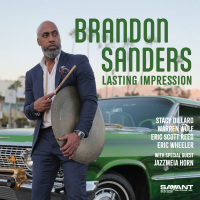Home » History of Jazz Timeline: 1933
History of Jazz Timeline: 1933
Armstrong cuts his last records (for this contract) for the Victor label. Sides can be found on the Bluebird CD Laughin' Louis 1932-1933 and Classics CD Louis Armstrong and His Orchestra 1932-1933.
Armstrong travels to Europe. He is a sensation everywhere that he plays. He fills the Tivoli in Copenhagen eight nights in a row.
Bessie Smith records for the last time in a session which is arranged by John Hammond. Gimme a Pigfoot was recorded at this session.
On June 2, the morning of Duke Ellington's departure for Europe on the SS Olympic, John Hammond takes a portable phonograph to Ellington as a bon voyage present. Ellington declines. He does not like Hammond and does not need his presents or advice.
The Ellington Band goes to Europe. Their reception in England is very good. The fans love Ellington and know most of the band members by name. Ellington discovers that he is considered a significant composer in London.
Ellington records Solitude and Sophisticated Lady.
Teddy Wilson is in New York City working with the Benny Carter band.
Billie Holiday is discovered in Monette's in New York City by --guess who-- John Hammond. Billie records with Benny Goodman.
On the morning of November 27, John Hammond records two tunes with Broadway star Ethel Waters. After this, he brings his new discovery Billie Holiday into the same studio for Waters to hear. Waters is not impressed, but that will not deter Hammond or Holiday.
Benny Goodman meets John Hammond. Hammond convinces him to hire heavy-handed drummer Gene Krupa and trombonist Jack Teagarden. In addition, Hammond persuades Goodman to hire black musicians, notably Billie Holiday and Teddy Wilson. This was a breakthrough. Goodman is ready. He is tired of following, he wants to lead. And lead he will.
Most musicians, even Benny Goodman, are having a tough time because of the depression. Goodman heads a pickup band that has been organized by John Hammond. The band includes Jack Teagarden, Gene Krupa and Joe Sullivan. They record "Ain'tcha Glad"/"I've Got a Right to Sing the Blues" for British Columbia. It is Benny's first record as a bandleader. It sells 5000 copies.
Coleman Hawkins, still with Henderson, is making his new style of improvising from the notes of the chords much more coherent and appealing.
Coleman Hawkins battles Kansas City tenor players Herschel Evans, Ben Webster and Lester Young at the Cherry Blossom at Twelfth Street and Vine in Kansas City, Mo. According to pianist Mary Lou Williams, Hawkins lost this battle because of Young's unconventional style.
Ben Webster is now with the Fletcher Henderson band.
Eddie Lang dies at the height of his powers at twenty-nine from complications following a tonsillectomy. This was a great loss to Jazz.
Django Reinhardt on guitar and Stephane Grapelli on violin begin to play together in Louis Vola's Hotel Claridge orchestra. This was the start of what might have been the greatest duo in Jazz. Django makes a recording of Si J'aime Suzy with L'Orchestra du Theatre Daunon. Lang's influences are showing.
Art Tatum makes his first solo records including Tiger Rag and Tea for Two. The stride is very evident on Tea for Two. Art is currently the biggest draw on 52nd Street. Tatum who has a better grasp of harmony than anyone currently in Jazz claims Fats Waller as his inspiration.
In the spring, Sidney Bechet (soprano saxophone, clarinet) and Tommy Ladnier (trumpet) quit music and open the Southern Tailor Shop at 128th Street and Nicholas Avenue in Harlem. Ladnier shines shoes and Bechet presses and delivers.
Walter Page's Blue Devils disband in West Virginia. Zack Whyte tries to get nine of the Blue Devils to join his band. They refuse telling him that it's all of us or none of us.
Future Free Jazz pianist Cecil Taylor is born in Corona, Long Island, New York where he grew up.
Benny Carter is chosen by English composer and critic Spike Hughes to organize a group to record a set of Hughes compositions.
Pianist Errol Garner is now working professionally in Pittsburgh, Pa.
The Hot Club of France gives its first Jazz Concert with a group of lesser known black American musicians living in France at the time.
Wild Bill Davison moves to Milwaukee. He had been ostracized because a car that he was driving was hit by a cab killing the much beloved clarinet player Frank Teschemacher. The accident was not even Davison's fault!
Prohibition is repealed. Jazz moves out of the speakeasys. Speakeasys become legal bars. Joe Helbock's Onyx on 52nd Street in N.Y. becomes a very good draw. However, much competition moves in. 52nd Street will become legendary in Jazz annals.
The depression has taken its toll on most early Jazz musicians. A new breed is emerging. This new breed is the Swing musician.
Keyword Search
Disclaimer: Though we have checked our facts, this timeline may contain erroneous information. If you discover errors or omissions, please bring them to our attention.









